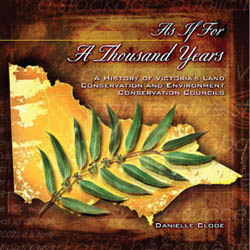As if for a thousand years
'From the earliest settlement struggles to the bloody Eureka stockade, public land use has excited the passions and fury of the general population.'

In 2006, the Victorian Environmental Assessment Council published a history of its predecessors, the Land Conservation Council and Environment Conservation Council, called As If for A Thousand Years and written by Dr Danielle Clode.
The book exposes the history of public land use changes in Victoria, along with the colourful characters, heated politics and successes of the organisations that helped to shape the uses.
The story follows how the Land Conservation Council and later the Environment Conservation Council became leading models for community consultation, surviving dramatic changes to the political and environmental landscape.
Author Dr Danielle Clode studied psychology and politics at Adelaide University, before completing a doctorate in zoology at Oxford. Since then she has worked as a freelance author, researcher and editor across a wide variety of science and humanities disciplines. She has taught creative and academic writing at Melbourne and Flinders University. Her books include the award-winning Voyages to the South Seas and the best-selling Megafauna of Australia. In 2018 she published The Wasp and the Orchid, a biography of the nature writer Edith Coleman (Picador) and a children's book From Dinosaurs to Diprotodons (Museums Victoria). Her latest book is In Search of the Woman who Sailed the World (Picador).
Synopsis:
When Bill Borthwick, Minister for Lands, delivered his welcoming speech to the newly formed Land Conservation Council in 1971, he advised them to make their recommendations on public land use for Victoria "as if for a thousand years". And with that he left them to it.
The Land Conservation Council was to provide a unique framework free from political intervention, where experts could debate public land use issues and recommend fair and balanced public land use, enshrining a representative reserve system for Victoria's remaining natural heritage. This is the story of the Land Conservation Council and how it developed into a leading model for community consultation, surviving dramatic changes to the political and environmental landscape but, despite name changes, remaining a stable and conciliatory force in the battle over public land in Victoria.
Available from the Victorian Environmental Assessment Council or to download here.